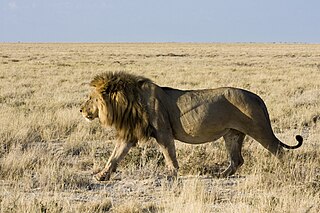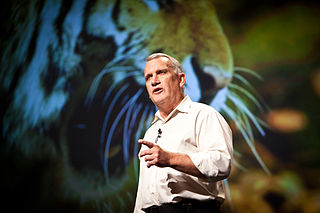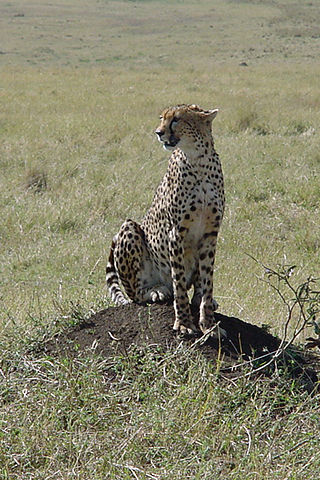Related Research Articles

The lion is a large cat of the genus Panthera native to Africa and India. It has a muscular, broad-chested body; short, rounded head; round ears; and a hairy tuft at the end of its tail. It is sexually dimorphic; adult male lions are larger than females and have a prominent mane. It is a social species, forming groups called prides. A lion's pride consists of a few adult males, related females, and cubs. Groups of female lions usually hunt together, preying mostly on large ungulates. The lion is an apex and keystone predator; although some lions scavenge when opportunities occur and have been known to hunt humans, lions typically do not actively seek out and prey on humans.

The cheetah is a large cat native to Africa and Southwest Asia. It is the fastest land animal, capable of running at 80 to 98 km/h, as such has evolved specialized adaptations for speed, including a light build, long thin legs and a long tail. It typically reaches 67–94 cm (26–37 in) at the shoulder, and the head-and-body length is between 1.1 and 1.5 m. Adults weigh between 21 and 72 kg. Its head is small and rounded, with a short snout and black tear-like facial streaks. The coat is typically tawny to creamy white or pale buff and is mostly covered with evenly spaced, solid black spots. Four subspecies are recognised.
David Whyte MacdonaldCBE FRSE is a Scottish zoologist and conservationist. He is the Director of the Wildlife Conservation Research Unit (WildCRU) at the University of Oxford, which he founded in 1986. He holds a Senior Research Fellowship at Lady Margaret Hall with the Title of Distinction of Professor of Wildlife Conservation. He has been an active wildlife conservationist since graduating from Oxford.
Claudio Sillero-Zubiri is an Argentine-born British zoologist. He is a Professor of Conservation Biology at Oxford University's WildCRU, the Wildlife Conservation Research Unit, and Bill Travers Fellow at Lady Margaret Hall. He is the Chair of the IUCN/SSC Canid Specialist Group, and Chief Scientist of the Born Free Foundation. He is internationally recognized for his work with carnivore conservation, and in particular the endangered Ethiopian wolf.

The Wildlife Conservation Research Unit (WildCRU) is part of the Department of Zoology at the University of Oxford in England. Its mission is to achieve practical solutions to conservation problems through original scientific research, training conservation scientists to conduct research, putting scientific knowledge into practice, and educating and involving the public to achieve lasting solutions.

Ruaha National Park is a national park in Tanzania. The addition of the Usangu Game Reserve and other important wetlands to the park in 2008 increased its size to about 20,226 km2 (7,809 sq mi).
The Born Free Foundation is an international wildlife charity that campaigns to "Keep Wildlife in the Wild". It protects wild animals in their natural habitat, campaigns against the keeping of wild animals in captivity and rescues wild animals in need. It also promotes compassionate conservation, which takes into account the welfare of individual animals in conservation initiatives. Born Free also creates and provides educational materials and activities that reflect the charity’s values.

Panthera leo melanochaita is a lion subspecies in Southern and East Africa. In this part of Africa, lion populations are regionally extinct in Lesotho, Djibouti and Eritrea, and are threatened by loss of habitat and prey base, killing by local people in retaliation for loss of livestock, and in several countries also by trophy hunting. Since the turn of the 21st century, lion populations in intensively managed protected areas in Botswana, Namibia, South Africa and Zimbabwe have increased, but declined in East African range countries. In 2005, a Lion Conservation Strategy was developed for East and Southern Africa.

Alan Robert Rabinowitz was an American zoologist who served as the president, CEO, and chief scientist at Panthera Corporation, a nonprofit conservation organization devoted to protecting the world's 40 wild cat species. Called the "Indiana Jones of Wildlife Protection" by Time, he studied jaguars, clouded leopards, Asiatic leopards, tigers, Sumatran rhinos, bears, leopard cats, raccoons, cervidae, and civets.

Human–wildlife conflict (HWC) refers to the negative interactions between human and wild animals, with undesirable consequences both for people and their resources, on the one hand, and wildlife and their habitats on the other. HWC, caused by competition for natural resources between human and wildlife, influences human food security and the well-being of both humans and animals. In many regions, the number of these conflicts has increased in recent decades as a result of human population growth and the transformation of land use.
Thomas Scott Kaplan is an American billionaire businessman, philanthropist and art collector. Kaplan is the world's largest private collector of Rembrandt's works.

Panthera Corporation, or Panthera, is a charitable organization devoted to preserving wild cats and their ecosystems around the globe. Founded in 2006, Panthera is devoted to the conservation of the world’s 40 species of wild cats and the vast ecosystems they inhabit. Their team of biologists, data scientists, law enforcement experts and wild cat advocates studies and protects the seven species of big cats: cheetahs, jaguars, leopards, lions, pumas, snow leopards and tigers. Panthera also creates targeted conservation strategies for the world’s most threatened and overlooked small cats, such as fishing cats, ocelots and Andean cats. The organization has offices in New York City and Europe, as well as offices in Mesoamerica, South America, Africa and Asia.
The Naankuse Foundation Wildlife Sanctuary, also stylized Nǀaʼankusê, is a wildlife sanctuary in central Namibia, situated c. 42 kilometres (26 mi) outside Windhoek. Besides the sanctuary the establishment also runs a carnivore conservation research programme, the Clever Cubs pre-primary school, and a clinic for the San people. Nǀaʼankusê is a Juǀ'hoan word that means "God will protect us", or "God watches over us." The sanctuary opened in 2007. It is run by Namibian conservationist Marlice van Vuuren and her husband Rudie van Vuuren. Naankuse is funded by voluntary donations and relies on the time of volunteers to continue its projects.
The Wildlife Conservation Network (WCN) is a United States-based 501(c)(3) non-profit organization that protects endangered wildlife by supporting conservationists in the field who promote coexistence between wildlife and people. WCN does this by providing its partners with capital, strategic capacity-building services, training, and operational support. WCN has been given a top rating amongst wildlife conservation charities, with a four star rating on Charity Navigator.
The Mpanga-Kipengere Game Reserve is a protected area in Njombe Region of the Southern Highlands of Tanzania, East Africa. The reserve covers an area of 1,574 square kilometres (608 sq mi). The altitude ranges from 1,800 metres (5,906 ft) to 2,289 metres (7,510 ft). In addition to the preservation of wildlife the reserve is an important catchment for the headwaters of several rivers that feed into the Great Ruaha River and provide water for the Usangu wetlands.

The East African cheetah, is a cheetah population in East Africa. It lives in grasslands and savannas of Tanzania, Kenya, Uganda and Somalia. The cheetah inhabits mainly the Serengeti ecosystem, including Maasai Mara, and the Tsavo landscape.

Human–lion conflict refers to the pattern of problematic interactions between native people and lions. Conflict with humans is a major contributor of the decline in lion populations in Africa. Habitat loss and fragmentation due to conversion of land for agriculture has forced lions to live in closer proximity to human settlements. As a result, conflict is often characterized by lions preying upon livestock, known as livestock depredation. When depredation events take place, farmers suffer financial losses and lions face threats of retaliatory killing.

The Southern Acacia–Commiphora bushlands and thickets is a tropical grasslands, savannas, and shrublands ecoregion in Tanzania and Kenya. It includes portions of Serengeti National Park and Ngorongoro Conservation Area, which are designated World Heritage Sites and biosphere reserves for their outstanding wildlife and landscapes. It is one of three Acacia–Commiphora bushlands and thickets ecoregions in eastern Africa.

Anjali Watson is a Sri Lankan conservationist. She is known for her contributions to leopard conservation and founded the Wilderness and Wildlife Conservation Trust, a conservation and research organisation.
Alexandra Zimmermann is a conservation scientist specialising in conflict resolution in wildlife conservation based in Oxford, England, United Kingdom. She is known for founding the IUCN Human-Wildlife Conflict Task Force and is also a researcher at the University of Oxford Wildlife Conservation Research Unit (WildCRU). She is also a Senior Advisor for the World Bank's Global Wildlife Program. She has published over 50 research papers.
References
- ↑ "Amy Dickman Director of WildCRU". Department of Biology, University of Oxford.
- ↑ Ingram, Simon (31 January 2020). "Single white woman living tent studying lions". National Geographic. National Geographic. Retrieved 7 January 2022.
- ↑ "Lion Landscapes about us". Lion Landscapes.
- ↑ Calkin, Jessamy. "Why this British Woman is Fighting to Save African Lions from Extinction'". The Telegraph. Retrieved 7 January 2022.
- ↑ "Celebrity power undermining global conservation". The Guardian. 15 January 2021.
- ↑ "Why trophy hunting helps protect animals". The Economist.
- ↑ "The complex issue of big game hunting". The Guardian.
- ↑ "Professor Amy Dickman". Pembroke College, Oxford. Retrieved 7 January 2022.
- ↑ Dickman, A. J. (March 2009). Key determinants of conflict between people and wildlife, particularly large carnivores, around Ruaha National Park, Tanzania. UCL Library (Doctoral). Retrieved 7 January 2022.
- ↑ "Lion Landscapes about us". Lion Landscapes.
- ↑ "Lion Pride Aliance: Who we are". Pride Lion Aliance. Retrieved 7 January 2022.
- ↑ "Amy Dickman National Geographic Explorer". National Geographic Explorers.
- ↑ "IUCN Cat Specialist Group Members: Amy Dickman". IUCN Cat Specialist Group.
- ↑ "African Lion Working Group Members".
- ↑ "Welcome to our new associate editors 2019". British Ecological Society. 21 January 2019.
- ↑ "Google Scholar Profile Amy Dickman". Google Scholar. Retrieved 7 January 2022.
- ↑ "November 2011 newsletter" (PDF). Panthera.org.
- ↑ "Awards 2016" . Retrieved 7 January 2022.
- ↑ "Cincinnati Zoo Awards citation". Cincinnati Zoo. Retrieved 7 January 2022.
- ↑ "Tusk Award Finalist 2014 Amy Dickman". Tusk. Retrieved 7 January 2022.
This article needs additional or more specific categories .(January 2022) |